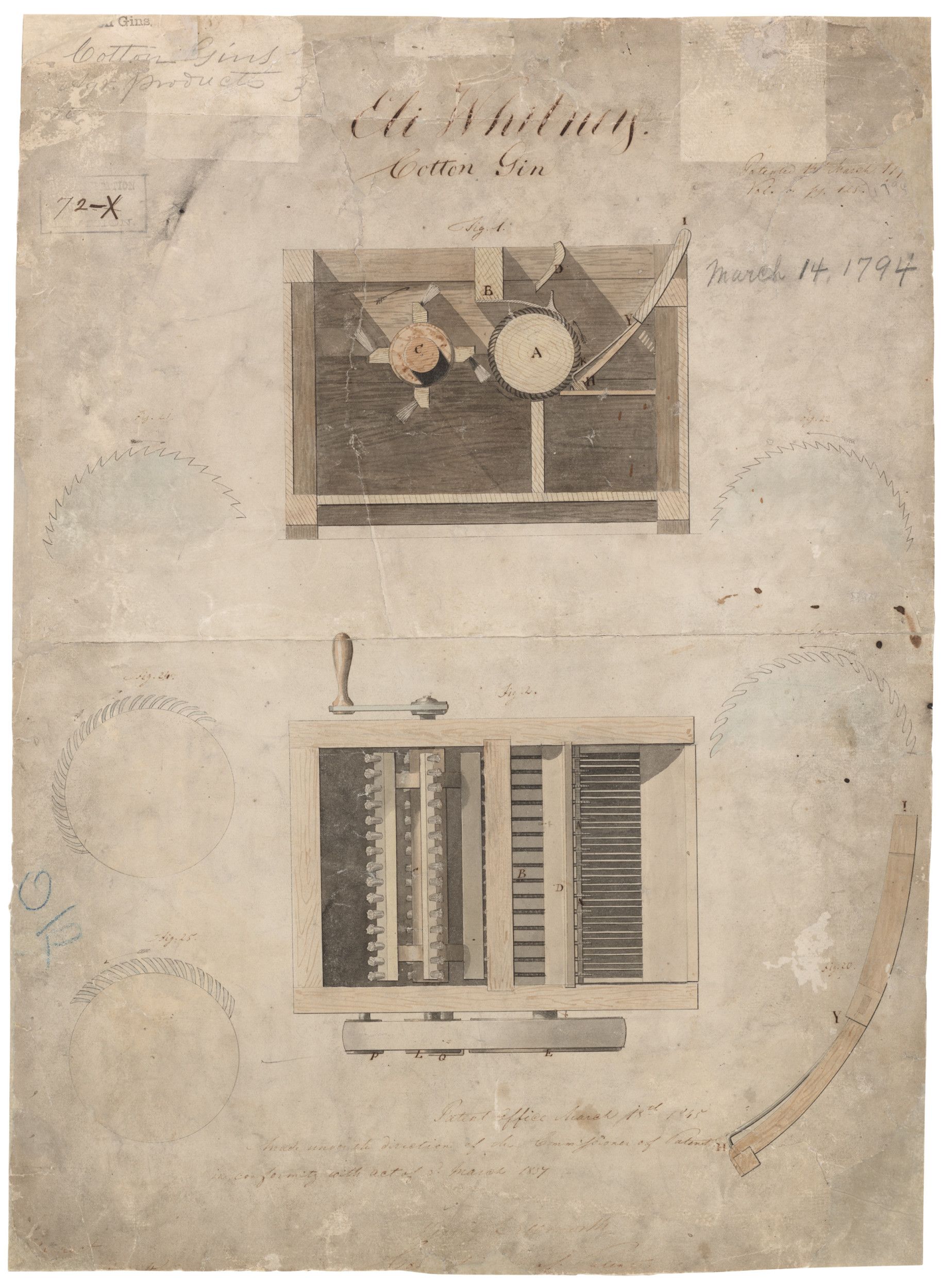Eli Whitney's Cotton Gin Patent Drawing
3/14/1794
Add to Favorites:
Add all page(s) of this document to activity:

Eli Whitney's cotton gin – for which he received a patent on March 14, 1794 – introduced a new, profitable technology to agricultural production in America.
The cotton gin is a device for removing the seeds from cotton fiber. Such machines had been around for centuries when Eli Whitney made his improvements in 1794. However, Whitney's was the first to clean short-staple cotton; and a single device could produce up to fifty pounds of cleaned cotton in a day. This made cotton a profitable crop for the first time.
After this invention, the yield of raw cotton doubled each decade after 1800. Demand was fueled by other inventions of the Industrial Revolution, such as the machines to spin and weave it, and the steamboat to transport it. By the mid-1800s, America was growing three-quarters of the world's supply of cotton, most of it shipped to England or New England where it was manufactured into cloth. During this time, tobacco fell in value; rice exports at best stayed steady; and sugar began to thrive, but only in Louisiana. At mid-century the South provided three-fifths of America's exports—most of it in cotton.
Ultimately, however, the most significant impact of the cotton gin was on the growth of slavery. Though the cotton gin reduced the labor of removing seeds, it did not reduce the number of enslaved people forced to grow and pick the cotton. In fact, the opposite occurred. Cotton growing became so profitable for plantation owners that it greatly increased their demand for both land and enslaved labor. Because of the cotton gin, enslaved people labored on ever-larger plantations where work was more regimented and relentless.
The cotton gin is a device for removing the seeds from cotton fiber. Such machines had been around for centuries when Eli Whitney made his improvements in 1794. However, Whitney's was the first to clean short-staple cotton; and a single device could produce up to fifty pounds of cleaned cotton in a day. This made cotton a profitable crop for the first time.
After this invention, the yield of raw cotton doubled each decade after 1800. Demand was fueled by other inventions of the Industrial Revolution, such as the machines to spin and weave it, and the steamboat to transport it. By the mid-1800s, America was growing three-quarters of the world's supply of cotton, most of it shipped to England or New England where it was manufactured into cloth. During this time, tobacco fell in value; rice exports at best stayed steady; and sugar began to thrive, but only in Louisiana. At mid-century the South provided three-fifths of America's exports—most of it in cotton.
Ultimately, however, the most significant impact of the cotton gin was on the growth of slavery. Though the cotton gin reduced the labor of removing seeds, it did not reduce the number of enslaved people forced to grow and pick the cotton. In fact, the opposite occurred. Cotton growing became so profitable for plantation owners that it greatly increased their demand for both land and enslaved labor. Because of the cotton gin, enslaved people labored on ever-larger plantations where work was more regimented and relentless.
This primary source comes from the Records of the Patent and Trademark Office.
National Archives Identifier: 102278457
Full Citation: Eli Whitney's Cotton Gin Patent Drawing; 3/14/1794; Restored Patent Drawings, 1837 - 1847; Records of the Patent and Trademark Office, Record Group 241; National Archives at College Park, College Park, MD. [Online Version, https://www.docsteach.org/documents/document/whitney-cotton-gin-patent, April 25, 2024]Activities that use this document
- Analyzing the Cotton Gin Patent
Created by the National Archives Education Team
Rights: Public Domain, Free of Known Copyright Restrictions. Learn more on our privacy and legal page.



